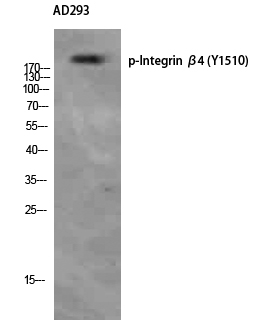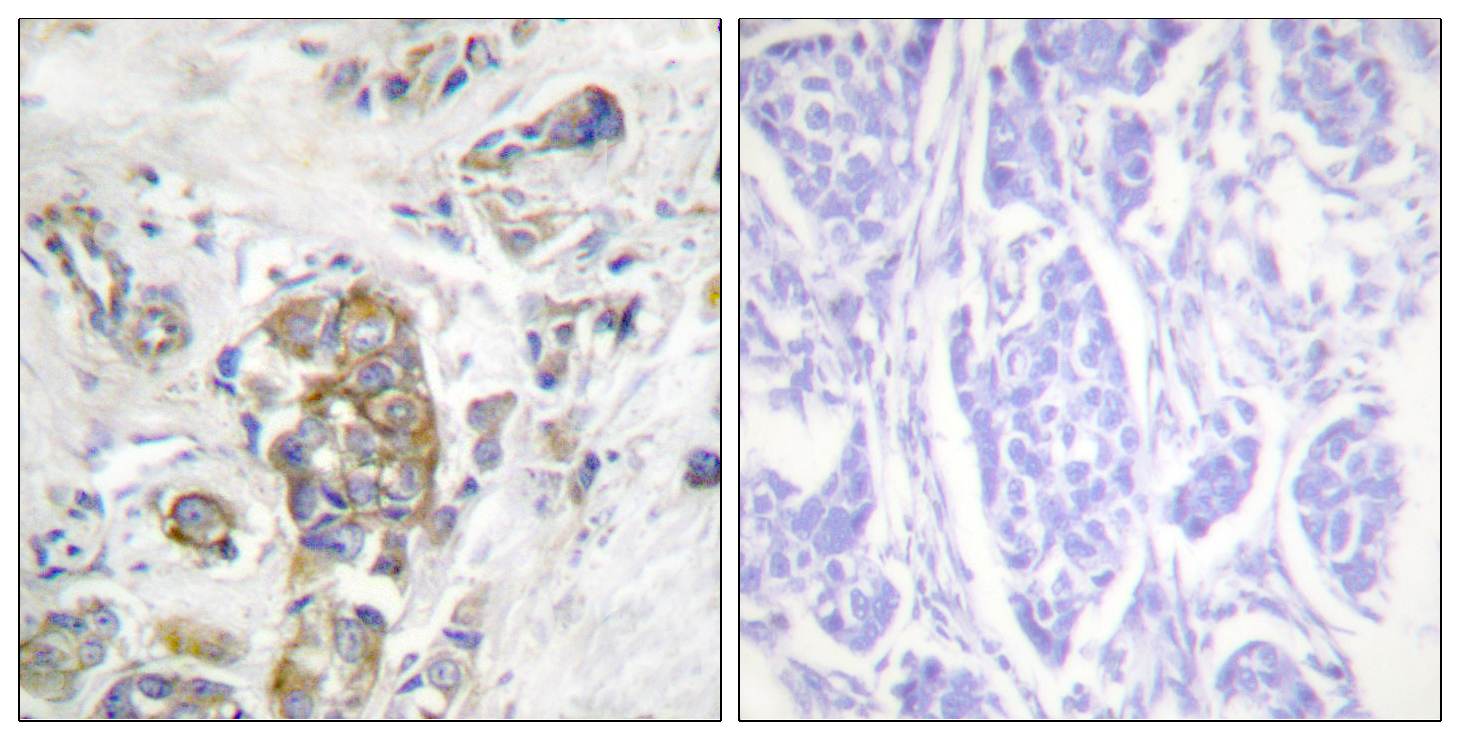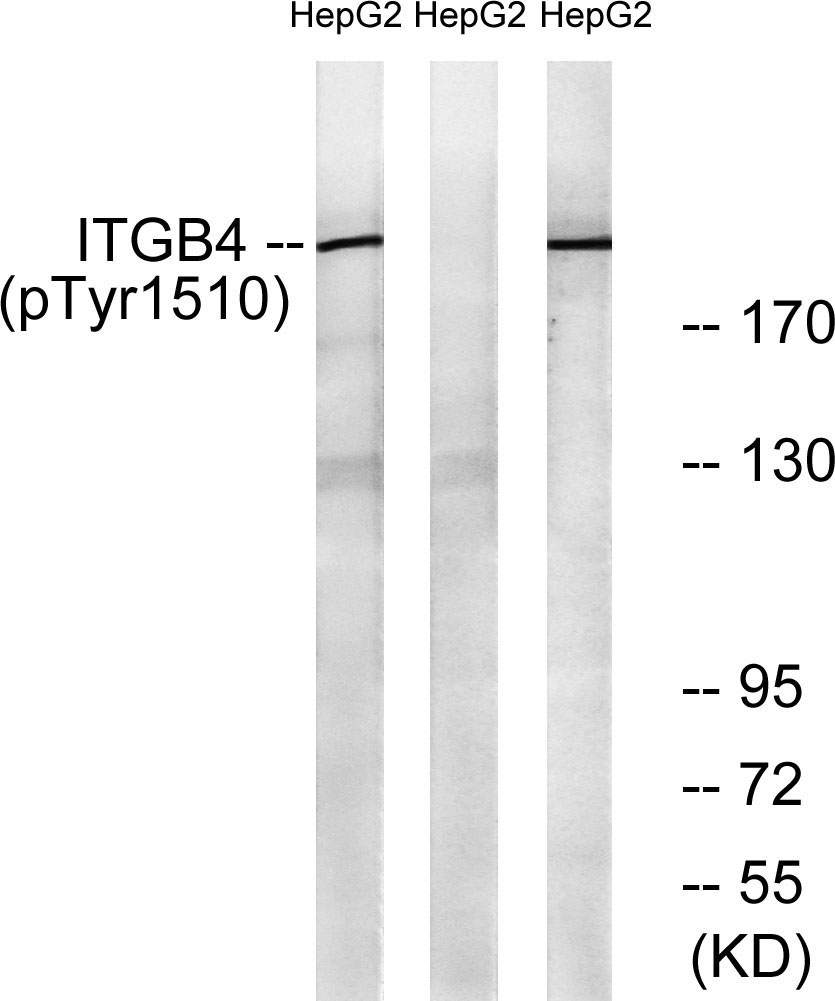Integrin β4 (phospho Tyr1510) Polyclonal Antibody
- Catalog No.:YP0755
- Applications:WB;IHC;IF;ELISA
- Reactivity:Human;Mouse;Rat
- Target:
- Integrin β4
- Fields:
- >>PI3K-Akt signaling pathway;>>Focal adhesion;>>ECM-receptor interaction;>>Regulation of actin cytoskeleton;>>Human papillomavirus infection;>>Hypertrophic cardiomyopathy;>>Arrhythmogenic right ventricular cardiomyopathy;>>Dilated cardiomyopathy
- Gene Name:
- ITGB4
- Protein Name:
- Integrin beta-4
- Human Gene Id:
- 3691
- Human Swiss Prot No:
- P16144
- Mouse Swiss Prot No:
- A2A863
- Rat Gene Id:
- 25724
- Rat Swiss Prot No:
- Q64632
- Immunogen:
- The antiserum was produced against synthesized peptide derived from human ITGB4 around the phosphorylation site of Tyr1510. AA range:1481-1530
- Specificity:
- Phospho-Integrin β4 (Y1510) Polyclonal Antibody detects endogenous levels of Integrin β4 protein only when phosphorylated at Y1510.
- Formulation:
- Liquid in PBS containing 50% glycerol, 0.5% BSA and 0.02% sodium azide.
- Source:
- Polyclonal, Rabbit,IgG
- Dilution:
- WB 1:500 - 1:2000. IHC 1:100 - 1:300. ELISA: 1:10000.. IF 1:50-200
- Purification:
- The antibody was affinity-purified from rabbit antiserum by affinity-chromatography using epitope-specific immunogen.
- Concentration:
- 1 mg/ml
- Storage Stability:
- -15°C to -25°C/1 year(Do not lower than -25°C)
- Other Name:
- ITGB4;Integrin beta-4;GP150;CD antigen CD104
- Observed Band(KD):
- 202kD
- Background:
- Integrins are heterodimers comprised of alpha and beta subunits, that are noncovalently associated transmembrane glycoprotein receptors. Different combinations of alpha and beta polypeptides form complexes that vary in their ligand-binding specificities. Integrins mediate cell-matrix or cell-cell adhesion, and transduced signals that regulate gene expression and cell growth. This gene encodes the integrin beta 4 subunit, a receptor for the laminins. This subunit tends to associate with alpha 6 subunit and is likely to play a pivotal role in the biology of invasive carcinoma. Mutations in this gene are associated with epidermolysis bullosa with pyloric atresia. Multiple alternatively spliced transcript variants encoding distinct isoforms have been found for this gene. [provided by RefSeq, Jul 2008],
- Function:
- disease:Defects in ITGB4 are a cause of epidermolysis bullosa letalis with pyloric atresia (EB-PA) [MIM:226730]; also known as junctional epidermolysis bullosa with pyloric atresia (PA-JEB) or aplasia cutis congenita with gastrointestinal atresia. EB-PA is an autosomal recessive, frequently lethal, epidermolysis bullosa with variable involvement of skin, nails, mucosa, and with variable effects on the digestive system. It is characterized by mucocutaneous fragility, aplasia cutis congenita, and gastrointestinal atresia, which most commonly affects the pylorus. Pyloric atresia is a primary manifestation rather than a scarring process secondary to epidermolysis bullosa.,disease:Defects in ITGB4 are a cause of generalized atrophic benign epidermolysis bullosa (GABEB) [MIM:226650]. GABEB is a non-lethal, adult form of junctional epidermolysis bullosa characterized by life-long blistering of
- Subcellular Location:
- Cell membrane; Single-pass type I membrane protein. Cell membrane; Lipid-anchor. Cell junction, hemidesmosome. Colocalizes with DST at the leading edge of migrating keratinocytes.
- Expression:
- Integrin alpha-6/beta-4 is predominantly expressed by epithelia. Isoform beta-4D is also expressed in colon and placenta. Isoform beta-4E is also expressed in epidermis, lung, duodenum, heart, spleen and stomach.
Meng, Xiangli, et al. "Integrin beta 4 (ITGB4) and its tyrosine-1510 phosphorylation promote pancreatic tumorigenesis and regulate the MEK1-ERK1/2 signaling pathway." Bosnian journal of basic medical sciences (2019).
- June 19-2018
- WESTERN IMMUNOBLOTTING PROTOCOL
- June 19-2018
- IMMUNOHISTOCHEMISTRY-PARAFFIN PROTOCOL
- June 19-2018
- IMMUNOFLUORESCENCE PROTOCOL
- September 08-2020
- FLOW-CYTOMEYRT-PROTOCOL
- May 20-2022
- Cell-Based ELISA│解您多样本WB检测之困扰
- July 13-2018
- CELL-BASED-ELISA-PROTOCOL-FOR-ACETYL-PROTEIN
- July 13-2018
- CELL-BASED-ELISA-PROTOCOL-FOR-PHOSPHO-PROTEIN
- July 13-2018
- Antibody-FAQs
- Products Images

- Western Blot analysis of AD293 using Phospho-Integrin β4 (Y1510) Polyclonal Antibody. Antibody was diluted at 1:500

- Enzyme-Linked Immunosorbent Assay (Phospho-ELISA) for Immunogen Phosphopeptide (Phospho-left) and Non-Phosphopeptide (Phospho-right), using ITGB4 (Phospho-Tyr1510) Antibody

- Immunohistochemistry analysis of paraffin-embedded human breast carcinoma, using ITGB4 (Phospho-Tyr1510) Antibody. The picture on the right is blocked with the phospho peptide.

- Western blot analysis of lysates from HepG2 cells treated with Na2VO3 0.3nM 40', using ITGB4 (Phospho-Tyr1510) Antibody. The lane on the right is blocked with the phospho peptide.



